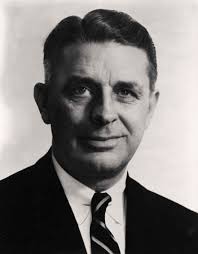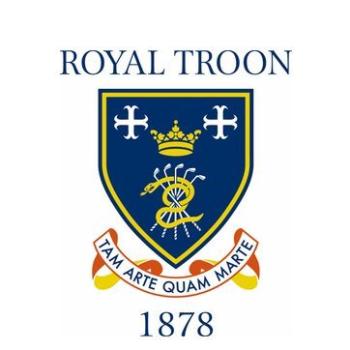 Joseph C. Dey Jr. became the PGA Tour’s first commissioner, in 1969. He directed it for the next five years. Mr. Dey was a much respected man in the game of golf. Nevertheless, Joe was like Jesus–a good guy who had a few enemies. I think most of this animosity was not personally directed against him. For a few Touring pro golfers, Mr. Dey came to work for the PGA Tour with one bad swing. This no doubt will come as a surprise to pro golf fans. It was that Joe Dey had worked for the United States Golf Association (USGA) as its executive director from 1934 to 1968.
Joseph C. Dey Jr. became the PGA Tour’s first commissioner, in 1969. He directed it for the next five years. Mr. Dey was a much respected man in the game of golf. Nevertheless, Joe was like Jesus–a good guy who had a few enemies. I think most of this animosity was not personally directed against him. For a few Touring pro golfers, Mr. Dey came to work for the PGA Tour with one bad swing. This no doubt will come as a surprise to pro golf fans. It was that Joe Dey had worked for the United States Golf Association (USGA) as its executive director from 1934 to 1968.
The USGA and the Royal and Ancient Golf Club at Saint Andrews, Scotland, have always been the two leading organizations which establish the rules of golf that are adhered to throughout the world. Their rules committees consist totally of amateur golfers. What!
Among sports, golf is most unusual due to its rules. It’s just the nature of the beast. In order for game to become as popular as it did, there had to be a large set of rules to which everyone could agreer. The main rules were to play the ball as it lies, no tapping down spike marks in the line of your putt on the green, and, of course, no foot mashies—simple stuff like that. Yet, these two ruling bodies often were not able to shake their reputation of being rather fickle. How so? Ever so often, they would change the rules. That made a lot of golfers frustrated, including the pros. Plus, many pros didn’t like amateurs making the rules.
Legendary pro Gene Sarazen was one of them. He invented the sand wedge and was one of the greatest pro golfers of all time. He competed in the first Ryder Cup competition, in 1927, with his playing captain Walter Hagen. In 1935, Gene hit the most famous shot in golf. The media dubbed it “the shot heard ‘round the world.” He holed his second shot across the pond on the par-five 15th hole at the Masters tournament in the last round. That gave Gene a double eagle en route to his winning the tournament.
I once played golf with the short and stocky Gene Sarazen, nicknamed “The Squire.” It was in the nine-hole 3-par event which traditionally precedes the Masters tournament on Wednesday. As always, Gene was wearing his trademark knickers. He then told me that because of the many changes in the rules of golf, he quit paying attention to the rule book a long time ago. Yet, over the many years, it seems to me that these two main ruling bodies in golf gradually and eventually got it right.
Nevertheless, back in the late 1960s and 1970s, the USGA was an organization that wasn’t well liked among some American Touring pros, even a few top pros. Why? The USGA is the premier organization for amateur golf in the U.S. And one of the four major professional golf tournaments in the world is theirs and therefore run by them—the U.S. Open. Many American Touring pros, including me, deemed the U.S. Open the greatest tournament in golf. Nevertheless, these outspoken pros would allege something like this about the USGA: “it’s run by a bunch of amateurs who don’t know what (the hell) they’re doing.”
Maybe not much has changed on this front. In early 2013, the USGA and the Royal and Ancient announced the banning of the long putter, to take effect in 2016. Two pros had recently won majors using the long putter: Keegan Bradley won the 2011 PGA Championship, and Webb Simpson won the 2012 U.S. Open. Then, in early 2013 Scott Adams won the Masters with a long putter. In a Tour players’ meeting in early 2013, new pro Robert Garrigus says he asked PGA TOUR Commissioner Tim Finchem concerning the USGA, “‘Out of the 15 board members that vote on our game, the professional game, how many of them have ever struck a shot in competition?’ And that was zero, and that’s all I need to hear. They’re amateurs policing a professional game.”[1] Yeah, some things never change.
On the other hand, the World Golf Hall of Fame, located in St. Augustine, Florida, has a profile on “Joseph Dey” on its website. It devotes much tribute to him. It says he introduced gallery ropes to golf tournaments starting with the 1954 USGA Open at Baltusrol. And it tells about him devising velocity regulations to curb ball distance. This website continues to praise Joseph Dey by saying,
“It was a surprise when he left the USGA at age 61 to head the newly formed Tournament Players Division of the Professional Golfers Association, but Dey felt he had a unique opportunity to create something beneficial to golf. At the time, the Tour was in turmoil, having just broken from the PGA of America after a prolonged dispute. It was a public relations nightmare for the touring professionals, but Dey brought the tour respectability and stability. ‘Joe was one of the few people that both sides would accept,’ said Jack Tuthill, the Tour’s former manager and director of tournament operations.
“Dey steered the ship through the hard times until Deane Beman could take over in 1974. THE PLAYERS Championship was Dey’s idea, as was the formation of a secondary tour [later] known as the Nationwide Tour [now the Web.com Tour], and the mandate that tournament sponsors employ a USGA agronomist to standardize playing conditions [which the Tour now does].
“Born in Norfolk, Va., Nov. 17, 1907, Dey considered entering the [Christian] ministry before deciding to make golf administration his career. He always carried two books in the pocket of his blue blazer, the Rules of Golf and the New Testament. He lived by the words of both. ‘In the world of golf,’ former USGA President William C. Campbell once said, ‘Joe Dey was the mightiest oak of all.'”[2]
The USGA held Joe Dey in such high esteem that in 1996, five years after his death, it started the Joe Dey Award. It is given annually to a most deserving individual in recognition of his/her honorable, volunteer service to American amateur golf.
So, with Joe Dey I think the PGA Tour got the right man for the job at the right time in Tour history. He helped avert what could have been a permanent split between the two, American, male, professional golf associations.
See “Joe Dey (Part 1 of 2)”
[1] The Arizona Republic, February 2, 2013.
[2] http://www.worldgolfhalloffame.org/hof/member.php?member=1048. Accessed on January 27, 2013.












